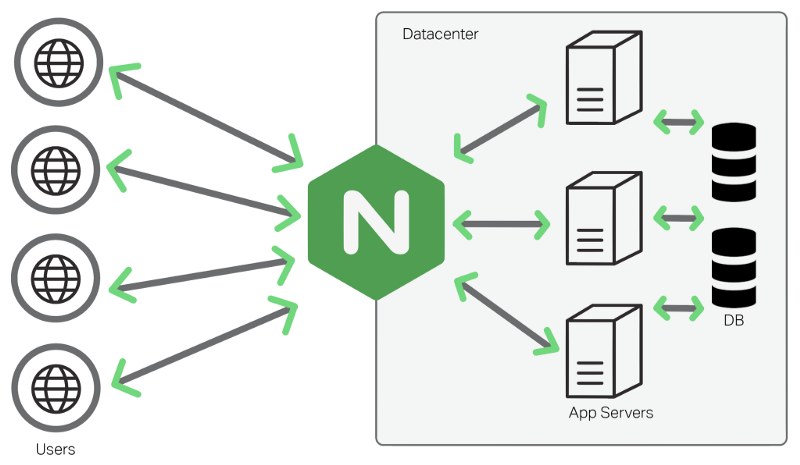
Awesome Repository
- awesome-nginx : A curated list of awesome Nginx distributions, 3rd party modules, Active developers, etc.
Articles
- Medium - Nginx Configuration File Explanation and Common Feature Configurations (90% Practical Use Rate)
- Myself - Create Free SSL with Let’s Encrypt and Certbot
- Blog - Nginx high availability through Keepalived – Virtual IP
- Nginx Docs - High Availability Support for NGINX Plus in On-Premises Deployments
Nginx Configuration
Default
user nginx;
worker_processes auto;
error_log /var/log/nginx/error.log notice;
pid /var/run/nginx.pid;
events {
worker_connections 1024;
}
http {
include /etc/nginx/mime.types;
default_type application/octet-stream;
open_file_cache max=2000 inactive=20s;
open_file_cache_valid 60s;
open_file_cache_min_uses 5;
open_file_cache_errors off;
client_max_body_size 10M;
log_format main '$remote_addr - $remote_user [$time_local] "$request" '
'$status $body_bytes_sent "$http_referer" '
'"$http_user_agent" "$http_x_forwarded_for"';
access_log /var/log/nginx/access.log main;
sendfile on;
keepalive_timeout 65;
include /etc/nginx/conf.d/*.conf;
}server {
listen 80;
listen [::]:80;
server_name localhost;
#access_log /var/log/nginx/host.access.log main;
location / {
root /usr/share/nginx/html;
index index.html index.htm;
}
#error_page 404 /404.html;
# redirect server error pages to the static page /50x.html
#
error_page 500 502 503 504 /50x.html;
location = /50x.html {
root /usr/share/nginx/html;
}
# proxy the PHP scripts to Apache listening on 127.0.0.1:80
#
#location ~ \.php$ {
# proxy_pass http://127.0.0.1;
#}
# pass the PHP scripts to FastCGI server listening on 127.0.0.1:9000
#
#location ~ \.php$ {
# root html;
# fastcgi_pass 127.0.0.1:9000;
# fastcgi_index index.php;
# fastcgi_param SCRIPT_FILENAME /scripts$fastcgi_script_name;
# include fastcgi_params;
#}
# deny access to .htaccess files, if Apache's document root
# concurs with nginx's one
#
#location ~ /\.ht {
# deny all;
#}
}Upstream for load balancer
Info
This
nginxconfiguration will contain something like
- upstream block: this block will hold the bunch of containers for making load balancer with multiple style
- server block: This server block will handle your request and response. This server block will cause redirect from (HTTP) 80 to (HTTPS) 443
# LB for backend containers
upstream backend {
server {{ be.name_origin_replica_backend }}:{{ be.port_origin_replica_backend }};
}
# LB for frontend containers
upstream frontend {
server {{ fe.name_origin_replica_frontend }}:{{ fe.port_origin_replica_frontend }};
}
# This server block for purpose redirect from HTTP to HTTPS
server {
if ($host = {{ ssl.app_server_name }}) {
return 301 https://$host$request_uri;
} # managed by Certbot
if ($host = {{ ssl.monitoring_server_name }}) {
return 301 https://$host$request_uri;
} # managed by Certbot
listen 80;
server_name {{ ssl.app_server_name }} {{ ssl.monitoring_server_name }};
return 404; # managed by Certbot
}
# This server block for purpose process the route traffic
server {
listen 443 ssl; # managed by Certbot
server_name {{ ssl.app_server_name }};
ssl_certificate /etc/letsencrypt/live/{{ ssl.monitoring_server_name }}/fullchain.pem; # managed by Certbot
ssl_certificate_key /etc/letsencrypt/live/{{ ssl.monitoring_server_name }}/privkey.pem; # managed by Certbot
include /etc/letsencrypt/options-ssl-nginx.conf; # managed by Certbot
ssl_dhparam /etc/letsencrypt/ssl-dhparams.pem; # managed by Certbot
# This configurable server block bot scanning via some browser
location = /robots.txt { return 200 "User-agent: *\nDisallow: /\n"; }
location / {
proxy_set_header X-Real-IP $remote_addr;
# Header for helping resolivng the server to work with another protocol. (e.g "wss:// ws://" (grpc will have another header))
proxy_set_header Upgrade $http_upgrade;
proxy_set_header Connection $connection_upgrade;
if ($host != {{ ssl.app_server_name }}) {
return 444;
}
if ($request_uri ~ ^/(api|auth|openapi)) {
proxy_pass http://backend$request_uri;
}
if ($request_uri !~ ^/(api|auth|openapi)) {
proxy_pass http://frontend$request_uri;
}
}
}Zero Downtime Basic Upstream SSL
Info
This block will help you handling blue-green deployment concept which can force traffic from blue to green with zero downtime and auto reload to backup container
# LB for backend containers
upstream backend {
server {{ be.name_origin_replica_backend }}:{{ be.port_origin_replica_backend }} max_fails=2 fail_timeout=3;
server {{ be.name_new_replica_backend }}:{{ be.port_new_replica_backend }} backup;
}
# LB for frontend containers
upstream frontend {
server {{ fe.name_origin_replica_frontend }}:{{ fe.port_origin_replica_frontend }};
}
# This server block for purpose redirect from HTTP to HTTPS
server {
if ($host = {{ ssl.app_server_name }}) {
return 301 https://$host$request_uri;
} # managed by Certbot
if ($host = {{ ssl.monitoring_server_name }}) {
return 301 https://$host$request_uri;
} # managed by Certbot
listen 80;
server_name {{ ssl.app_server_name }} {{ ssl.monitoring_server_name }};
return 404; # managed by Certbot
}
# This server block for purpose process the route traffic
server {
listen 443 ssl; # managed by Certbot
server_name {{ ssl.app_server_name }};
ssl_certificate /etc/letsencrypt/live/{{ ssl.monitoring_server_name }}/fullchain.pem; # managed by Certbot
ssl_certificate_key /etc/letsencrypt/live/{{ ssl.monitoring_server_name }}/privkey.pem; # managed by Certbot
include /etc/letsencrypt/options-ssl-nginx.conf; # managed by Certbot
ssl_dhparam /etc/letsencrypt/ssl-dhparams.pem; # managed by Certbot
location / {
proxy_set_header X-Real-IP $remote_addr;
if ($host != {{ ssl.app_server_name }}) {
return 444;
}
if ($request_uri ~ ^/(api|auth|openapi)) {
proxy_pass http://backend$request_uri;
}
if ($request_uri !~ ^/(api|auth|openapi)) {
proxy_pass http://frontend$request_uri;
}
}
}Work with websocket
- As you can see the backend have create some connections via
websocketprotocol and anything requested vianginx-server, so it need to be configured for resolved this one connection - All configuration can reference via article: NGINX as a WebSocket Proxy. So we can sum up the configuration for adding to nginx including
http{
# Setting up for nginx resolivng websocket to the backend
map $http_upgrade $connection_upgrade {
default upgrade;
'' close;
<some_another_configuration>
server {
location "/" {
# Header for helping resolivng the server to work with another protocol. (e.g "wss:// ws://" (grpc will have another header))
proxy_set_header Upgrade $http_upgrade;
proxy_set_header Connection $connection_upgrade;
<some_another_configuration>
}
}
}
}Nginx Template Portainer for Ansible
Abstract
Ansible Playbooks Template is used config for Nginx work with Portainer
# This block server for purpose route traffic to monitoring route
server {
listen 443 ssl; # managed by Certbot
server_name {{ ssl.monitoring_server_name }};
ssl_certificate /etc/letsencrypt/live/{{ ssl.monitoring_server_name }}/fullchain.pem; # managed by Certbot
ssl_certificate_key /etc/letsencrypt/live/{{ ssl.monitoring_server_name }}/privkey.pem; # managed by Certbot
include /etc/letsencrypt/options-ssl-nginx.conf; # managed by Certbot
ssl_dhparam /etc/letsencrypt/ssl-dhparams.pem; # managed by Certbot
location / {
proxy_set_header X-Real-IP $remote_addr;
if ($host != {{ ssl.monitoring_server_name }}) {
return 444;
}
proxy_pass https://{{ monitoring.name_origin_replica_monitoring }}:{{ monitoring.port_origin_replica_monitoring }};
}
# This part can help you access container via nginx with websocket
location /api/websocket/ {
proxy_set_header X-Real-IP $remote_addr;
proxy_set_header Upgrade $http_upgrade;
proxy_set_header Connection "upgrade";
proxy_http_version 1.1;
proxy_pass https://{{ monitoring.name_origin_replica_monitoring }}:{{ monitoring.port_origin_replica_monitoring }}/api/websocket/;
}
}